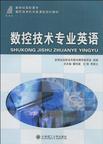数控技术专业英语
出版时间:2008-4 出版社:大连理工大学出版社 作者:李桂云 主编 页数:183
内容概要
《数控技术专业英语》是新世纪高职高专教材编审委员会组编的数控技术应用类课程规划教材之一。 本教材旨在使学生熟悉数控加工工艺、数控编程、数控机床操作与维护中常见的英文,为学生今后阅读相关的说明书及资料,掌握数控编程和操作及进一步学习打下良好的英语基础;本教材综合应用部分的内容能够拓宽学生的视野,有利于学生就业。 本教材在编写过程中力求突出以下特点: 1、课文选取紧密结合专业课教学内容,篇幅适度,难易适中。 2、精度部分由课文、词汇、注释、练习题等部分组成,每篇精读课文都有参考译文,练习题配有参考答案。 3、泛读内容与精读课文一一对应,方便有兴趣学生进一步学习。 4、根据课文内容,选择恰当的图片,使教材图文并茂,有助于学生更直观地理解教学内容。 5、附录中列出了常用地G代码、M代码、缩略语和数控加工常用词汇,方便学生查找与使用。 本教材共分为四各单元,分别使数控加工工艺、数控编程、数控机床操作与维护以及综合应用。
书籍目录
Unit One Technics of CNC Machining 1.1 Cutting Tools 1.2 Cutting Dosages 1.3 Usages of Measuring ToolsUnit Two CNC Program 2.1 Basic CNC Program 2.2 Program Code 2.3 Application of CNC ProgramUnit Three CNC Machines' Operation and Maintenance 3.1 CNC Machines 3.2 CNC Machines' Panel and Screen Reading 3.3 CNC Operation 3.4 NC Electrical Discharge Machining 3.5 Maintenance Troubileshooting and Safety Nores of CNC MachineUnit Four Integrated Applications 4.1 Application of CAD/ CAM Software 4.2 At CIMT 4.3 Applying for a Job 4.4 DialogueAppendix A G-Codes and M-Codes for FANUC CNC Milling MachineAppendix B AbbreviationsAppendix C Technical phrases参考文献
章节摘录
Cermets (from the words ceramic and metal) were first used in the early 1950s and consist of ceramic particles in a metallic matrix. They were introduced in the 1960s and are black or hot-pressed ceramics. Typical cermets consist of 70% aluminium oxide and 30% titanium carbide; other cermets contain molybdenum carbide, niobium carbide, and tantalum carbide. Although they have chemical stability and resistance to built-up-edge formation, the brittleness and high cost of cermets have been a limitation to their wider use. Further refinements of these tools have resulted in improved strength, toughness, and reliability. Their performance is somewhere between that of ceramics and carbides and has been particularly suitable for light roughing cuts and high-speed finiShing cuts, chipbreaker features are important for cermets inserts. Although they can be coated, the benefits of coated cermets are somewhat controversial, as the improvement in wear resistance appears to be marginal. There are three basic types of metal cutting tools : singlepoint tools, multipoint tools and abrasivesTM. A singlepoint metal cutting tool has a single cutting edge and is used for turning, boring, shaping and planning. The most common machine tools have two or more cutting edges such as drills, reamers and milling cutters. The cutting edge is that part of the tool where cutting is actually done. Grinding wheels are an example of abrasive cutting tools. Each grinding wheel has a lot of abrasive grains, which act as very cutting tools.
图书封面
评论、评分、阅读与下载
用户评论 (总计1条)
- 听说还可以
推荐图书
- Канель Г. Эксперимент
- Парадная книга Страны
- Стахорский С. Искания
- Моруа А. История Франц
- Сиратори Т. Новое пробуждение Япон
- Тепляков А. Процедура: исполнение с
- Ферр Г. Антисталинская подлость
- Фуртай Ф. Записки средневекового м
- Монфокон.Том 1
- Черный С. Стихотворения
- 新编质量技术监督行政执法手册
- Фроянов И. Загадка крещения Руси
- Акунин Б. Турецкий гамбит (зах.)
- 数学文化与社会进步
- Бершин Е. Маски духа
- Visual FoxPro程序设计教程
- Кучкина О. Смертельная любовь
- Современники о Патриархе Тихоне То
- 动物保护及福利
- Гофман А. Семь лекций
- Демидов Н. Творческое наследие. Т.3
- Райнер К. Микроскоп
- Мировая литература от античности д
- 兴国之路
- 建筑与室内设计透视图画法
相关图书
- 二十一世纪普通高等教育系列教材-线性代数
- 混凝土脱模剂和相关工程材料的应用
- 土体有效应力原理的通用公式与基坑支护及地基计算的实际水压力算法
- 针灸经穴触诊定位图谱
- 口腔修复
- 冠状动脉腔内成形术
- Best American Series 2006最佳美国人系列2006 银色礼盒封套
- 针灸腧穴与刺法发挥
- 妇科手术技术图解
- 产科手术技术图解
- 体育促销与销售管理
- 军事长篇亮剑文丛 天语
- 树立社会主义荣辱观
- 荣辱观
- 理想之舟-中国特色社会主义共同理想研究
- 精神航标
- 天使的蛋糕Angel Cake's Cupcake Book
- 无师自通
- 与大师约会
- 邮政金融零售信贷业务指南
- 权力的精神生活
- 卫生监督人员胜任力模型构建与素质测评研究
- Русские волшебные ска
- Джайлз А. Танцующий жи
- Образцов Тайная истор
